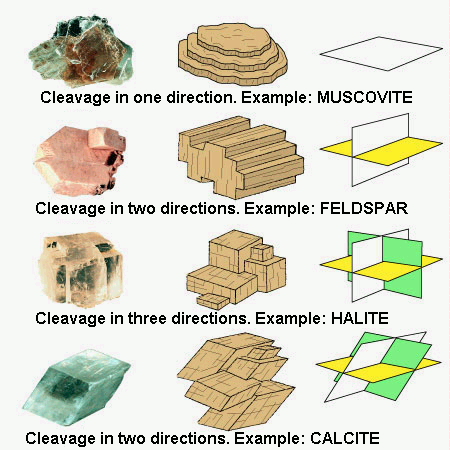Mineral Identification Lab
Last: _________________
First: ________________ Period: ____ Group: _____ Date: /
/
Group Members: ________________________,
________________________
Failure
is not an option! Read, Understand, Apply!
Investigative Question: How do physical properties
of minerals help us to identify them?
Materials: Student instructions, student worksheets, glass plate,
streak plate, magnifying glass, various minerals, ESRT
1. Introduction: Earth’s crust is
made up of many different rocks;
minerals are the solid, naturally occurring, inorganic matter, which have
specific chemical composition and unique internal atomic structure that make up
these rocks. Minerals play an important role in our modern world; they are
mined out of the Earth’s cruct and utilized by us for many purposes. Minerals
are used in construction, in cell phones, in computers, in nutrition, in our
bodies for many life functions, and
are also used in endless other ways! Each mineral has its own unique physical
properties that are based on internal arrangement of its atoms. We can use
these physical properties to accurately identify minerals.
a)
Luster
describes the manner in which light is reflected from the surface of a
mineral. Any mineral that shines with a
metal-like appearance has a metallic luster. Minerals that do not have a metallic luster
are termed nonmetallic (they could look glassy, like a pearl, dull, like
soil or like concrete). When working
with a mineral, determine if the luster of the mineral is metallic or nonmetallic.
b)
Cleavage is
the tendency of some minerals to break along flat planes. When broken, minerals that exhibit cleavage
produce smooth, flat surfaces parallel to each other, called cleavage
planes. Minerals that do not exhibit
cleavage when broken are said to fracture. Fracturing can be irregular, splintery, or
conchoidal (smooth curved surfaces resembling broken glass). When working with
a mineral, observe the sample and determine if it exhibits cleavage or fracture.
Some minerals that exhibit cleavage
c)
The streak of a mineral is the color of the
fine powder a mineral makes when it is rubbed on a surface. Streak of a mineral
can be colored or colorless or white (due to the color of
the streak plate). When working with a mineral, making one short line, rub each
mineral sample on the streak plate.
Testing for
Streak Testing for
hardness
d)
Hardness is
a measure of the resistance of a mineral to abrasion or scratching. It is a
relative property in that a harder substance will scratch a softer one. In this step testing hardness involves
scratching the mineral on a piece of glass.
If the mineral is harder, it will scratch the glass. If the mineral is softer, it will not scratch
the glass. Follow safety instructions and be extremely careful when handling the
glass. When working with a mineral, making one short line, scratch the mineral
on the glass to determine whether it is harder
or softer than glass. If you are not sure, try a few times.
Conclusion/Evaluation Questions: Answer in complete sentences and complete thoughts. Where applicable, use numerical values to
support your answers.
1. Use your ESRT “Properties of Common Minerals” to
complete the flow chart.
CONCLUSION/EVALUATION QUESTION 1.
Luster
|
Hardness
|
Cleavage or Fracture
|
Characteristics
|
Mineral Name
|
Nonmetallic
|
6
|
cleavage
|
striations
|
|
Nonmetallic
|
7
|
fracture
|
Dark red to green
|
|
Metallic
|
1-2
|
cleavage
|
Greasy feel
|
|
Metallic
|
6.5
|
fracture
|
Brassy yellow
|
|
Either
|
1-6.5
|
fracture
|
Red-brown streak
|
|
Nonmetallic
|
2-2.5
|
cleavage
|
Colorless to yellow
|
|
Nonmetallic
|
2.5-3
|
cleavage
|
Flexible thin sheets
|
|
Nonmetallic
|
2.5
|
cleavage
|
Salty taste
|
|
2. “Dig This Mining” company discovered what is believed to be a mineral that has never been seen before. You are a geologist who has been hired to identify it. Explain step by step, how you would identify this mineral.
3. You are a geologist who has been sent on an expedition to the Amundsen-Scott Research Center in the South Pole. As an expert in your field, one of your research partners turns to you to ask a question about geology: “Hey, this ice has been here for a very long time, is it considered a mineral? Answer your partner’s question and explain why or why not the ice at the South Pole is considered a mineral.
4. Using complete sentences, explain what gives a mineral its physical properties
5. You are the prosperous owner of “Give Me Your Stuff Pawn Shop.” A person comes with what he claims to be a gold bracelet, but you have a doubt about it and need to determine if it is a real or fake. What properties would this bracelet have if it were fake gold? How would you know if it is real or fake?
.jpg)
.jpg)
.jpg)










